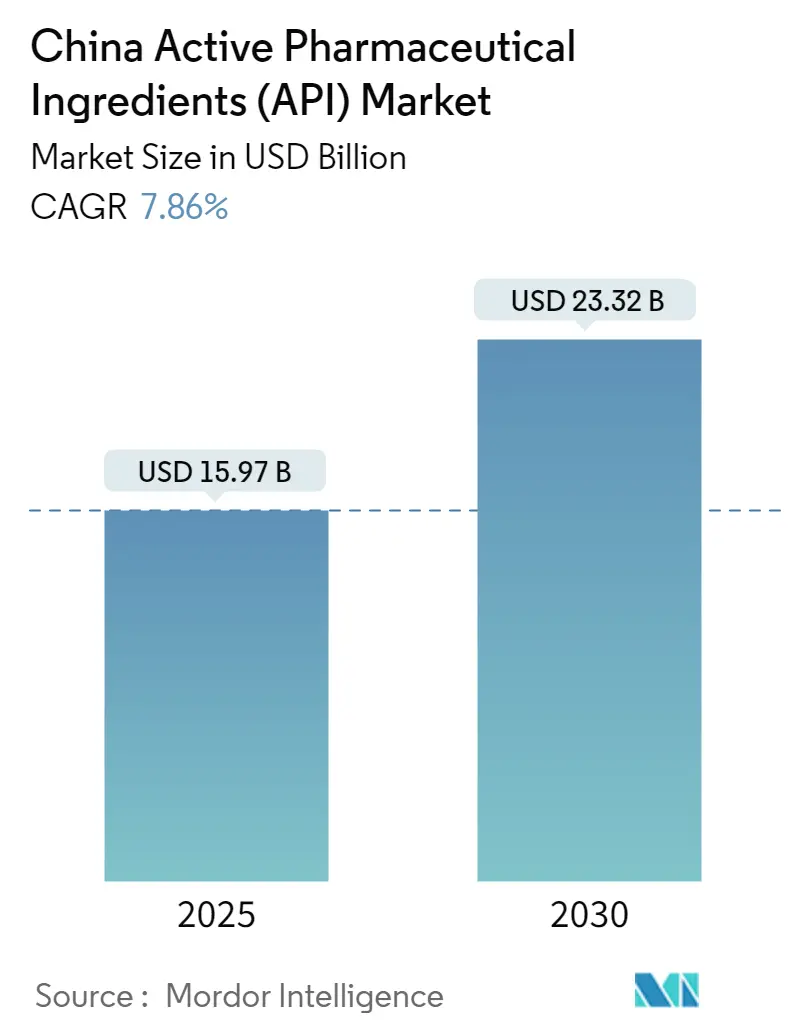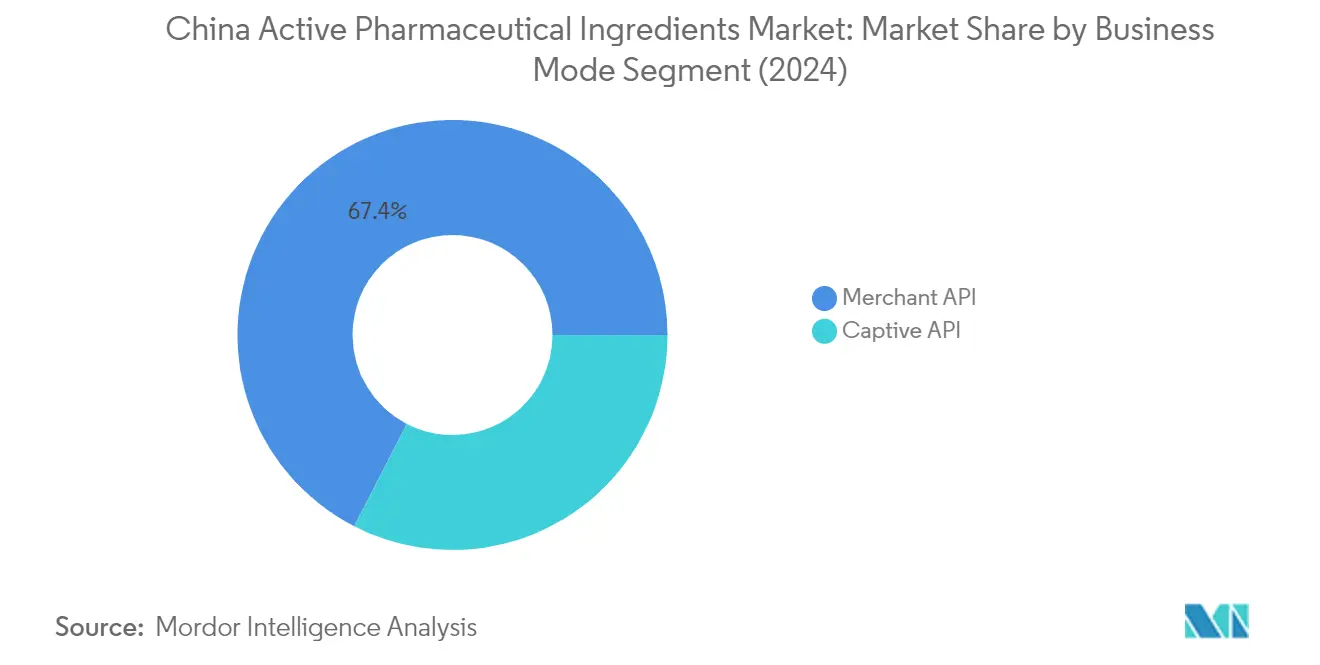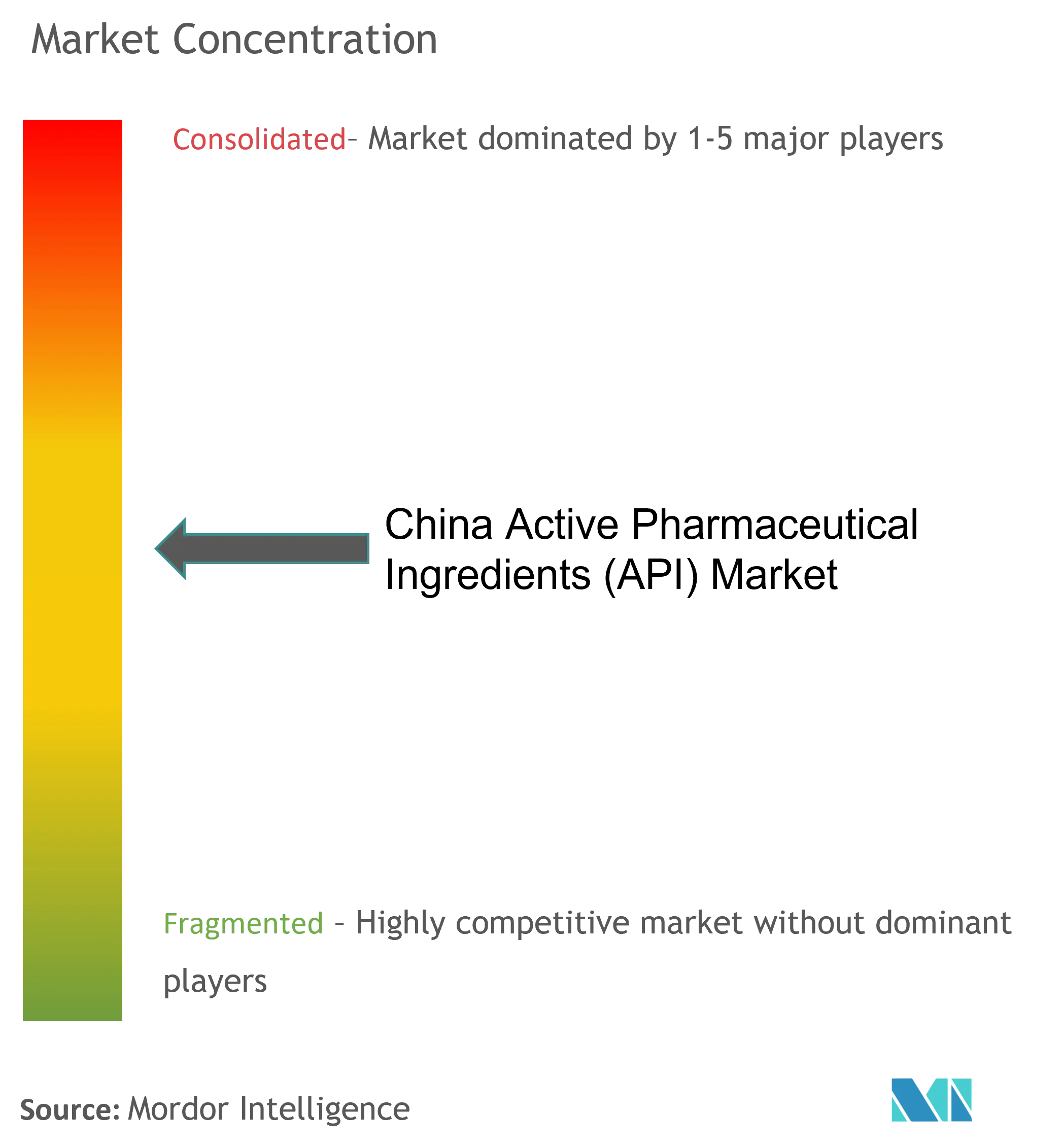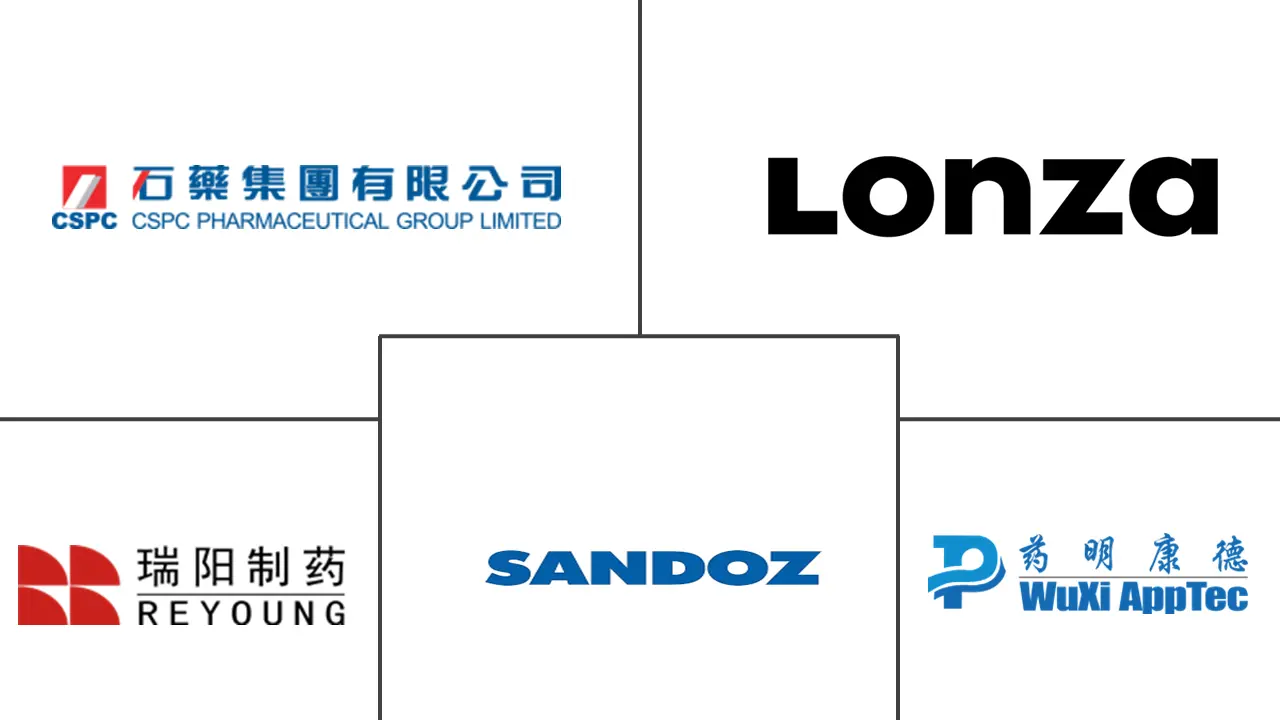
China Active Pharmaceutical Ingredients (API) Market Analysis by Mordor Intelligence
The China Active Pharmaceutical Ingredients Market size is estimated at USD 15.97 billion in 2025, and is expected to reach USD 23.32 billion by 2030, at a CAGR of 7.86% during the forecast period (2025-2030).
China's active pharmaceutical ingredients (API) industry is undergoing significant regulatory transformation to align with international standards and enhance quality control measures. In December 2023, China implemented comprehensive drug regulations encompassing various aspects such as API registration renewal, manufacturing outsourcing by marketing authorization holders (MAHs), and enhanced drug inspection protocols. These regulatory reforms demonstrate China's commitment to strengthening its position in the global pharmaceutical supply chain while ensuring product quality and safety. The National Medical Products Administration (NMPA) has shown increased efficiency in drug approvals, with approximately 87 innovative drugs receiving approval in 2023, reflecting the market's growing sophistication and regulatory maturity.
The industry is witnessing substantial investments in advanced API manufacturing capabilities and technological innovation. In January 2024, WuXi AppTec established a state-of-the-art API manufacturing facility in Taixing, China, significantly expanding its peptide manufacturing capacity to meet growing global demand. Similarly, AstraZeneca announced a USD 26.5 million investment in January 2024 to construct production lines for metformin hydrochloride and dapagliflozin, demonstrating the continued attraction of China's active pharmaceutical ingredients manufacturing sector for global pharmaceutical companies. These investments are accompanied by the adoption of advanced technologies such as continuous manufacturing, process automation, and green chemistry initiatives.
The market is experiencing a significant shift toward high-value API production, particularly in specialized therapeutic areas. According to recent industry data, WuXi TIDES supported approximately 50 preclinical to commercial-stage peptide projects and produced more than 15 metric tons of peptide APIs and intermediates in 2023, highlighting the growing sophistication of China's API manufacturing capabilities. The industry is increasingly focusing on developing complex APIs, including high potency APIs, peptides, and specialized therapeutic compounds, moving beyond traditional generic API production.
The healthcare landscape in China continues to drive API demand, with demographic and health trends shaping market dynamics. According to the International Diabetes Federation, China's diabetic population is projected to increase from 140.8 million in 2021 to 174.4 million by 2045, while WHO statistics indicate that 6.40% of China's population (approximately 1.43 billion people) was classified as obese in 2022. These health indicators are prompting pharmaceutical companies to expand their API production capabilities, particularly for chronic disease management medications. The industry is responding through increased investment in research and development, facility expansions, and the adoption of advanced manufacturing technologies to meet this growing demand.
China Active Pharmaceutical Ingredients (API) Market Trends and Insights
Increasing Prevalence of Chronic Disorders
The rising burden of chronic diseases in China has become a significant driver for the active pharmaceutical ingredients market, with cancer and cardiovascular diseases leading the increasing disease prevalence. According to an article published in the British Ecological Society in March 2023, approximately 330 million people were suffering from cardiovascular diseases (CVDs) in China, with conditions like coronary heart disease, stroke, atrial fibrillation, and pulmonary heart disease being most prevalent. The alarming increase in cardiovascular disorders has led to a surge in demand for innovative medicines, subsequently driving the need for pharmaceutical ingredients in drug manufacturing. Additionally, according to an article published in BMC Public Health in June 2023, about 40 million people in China are expected to suffer from Alzheimer's disease and related dementias by 2050, further emphasizing the growing chronic disease burden.
The oncology burden in China continues to rise significantly, creating substantial demand for cancer-treating therapeutic ingredients. According to NCBI projections from February 2022, approximately 4.8 million new cancer cases were expected to be reported in China in 2022, with this number projected to increase to 6.85 million new cancer cases by 2040. The increasing disease burden has prompted pharmaceutical companies to expand their API manufacturing capabilities. For instance, in January 2024, WuXi AppTec tripled its peptide manufacturing capacity by establishing a new API manufacturing site in Taixing, China, increasing the company's solid-phase peptide synthesis (SPPS) total reactor volume to 32,000 liters amid increased global demand for peptide therapeutics. This expansion directly responds to the growing need for APIs in cancer drug development and other chronic disease treatments.
Increasing Adoption and Approval of Biologics and Biosimilars
The growing adoption and approval of biologics and biosimilars in China has emerged as a crucial driver for the biological active pharmaceutical ingredients market. According to an article published by JAMA Network Open in October 2023, as of February 2023, the Chinese regulatory authority had approved approximately 20 biosimilars developed by local companies, positioning China as one of the prominent biosimilar manufacturers after the United States and Europe. The increasing focus on biosimilar development has led to significant investments in pharmaceutical chemical manufacturing infrastructure. For instance, in January 2024, Biogen and Eisai's Leqembi received approval from China's National Medical Products Administration, making China the third country after the United States and Japan to approve this antibody-based therapeutic for Alzheimer's disease treatment.
The supportive regulatory environment and strategic initiatives by pharmaceutical companies have further accelerated the adoption of biologics and biosimilars. In January 2024, Bayer AG and RTW Investments, LP invested USD 35 million and 127 million respectively in Ji Xing Pharmaceuticals Limited of China to accelerate the development of cardiovascular and ophthalmology medicines. Additionally, in March 2023, Bio-Thera Solutions' tocilizumab biosimilar (BAT1806) received approval from China National Medical Products Administration (NMPA) for treating several rheumatic conditions. These developments have created a robust pipeline of biological products, driving the demand for high-quality drug substances. The trend is further supported by the Chinese government's implementation of various policies and measures that encourage innovative and global drug development, significantly improving review timelines and processes for gaining new drug and clinical trial approvals.
Segment Analysis: By Business Mode
Merchant API Segment in China Active Pharmaceutical Ingredients Market
The Merchant API segment dominates the China Active Pharmaceutical Ingredients market, holding approximately 67% market share in 2024. This significant market position is attributed to increasing partnerships between key market players, coupled with extensive API facility expansions across China. The segment's growth is primarily driven by the higher demand for APIs in manufacturing finished dosage forms and the presence of numerous manufacturers offering merchant APIs to pharmaceutical companies. Major companies like Reyoung Pharmaceuticals, Zhejiang NHU Co., Ltd., and WuXi AppTec have established strong capabilities in producing APIs in large quantities at competitive costs compared to third-party manufacturers. Strategic initiatives such as facility expansions, investments, and business collaborations have further strengthened this segment's position, as evidenced by WuXi AppTec's opening of a new API manufacturing facility at the Taixing site in Jiangsu, China, in early 2024.

Captive API Segment in China Active Pharmaceutical Ingredients Market
The captive API segment is projected to experience the fastest growth in the China Active Pharmaceutical Ingredients market, with an expected growth rate of approximately 6% during the forecast period 2024-2029. This accelerated growth is primarily driven by pharmaceutical companies' increasing focus on vertical integration and the rising demand for biosimilars and generic formulations in China. The segment's expansion is further supported by the country's supportive government policies promoting local API production, as evidenced by initiatives like "Made in China 2025." The growth is also bolstered by the advantages associated with captive API manufacturing, including tighter supply chain integration, improved quality control, and greater flexibility in production planning. Additionally, the segment benefits from cost savings and competitive advantages gained through reduced dependence on external suppliers of active pharmaceutical ingredients.
Segment Analysis: By Synthesis Type
Synthetic Segment in China Active Pharmaceutical Ingredients (API) Market
The synthetic API segment dominates the China Active Pharmaceutical Ingredients (API) market, holding approximately 76% market share in 2024. This significant market position is primarily driven by the cost-effectiveness associated with synthetic APIs and the growing demand for small molecule drugs. The segment's strength is further reinforced by several strategic initiatives undertaken by key market participants, such as Lonza's expansion of its mid-scale manufacturing capacity in China through the establishment of a new mid-scale synthetic API manufacturing site. The expansion included advanced facilities with four 1,500L reactors, six 1,000L reactors, and isolation equipment for early-phase and late-phase production, demonstrating the industry's commitment to meeting the increasing demand for synthetic APIs. Additionally, companies like The Flamma Group have made substantial investments of around USD 200 million to expand their API business and revamp GMP facilities in China, specifically focusing on enhancing the production capabilities for small-molecule and other synthetic APIs.
Biotech Segment in China Active Pharmaceutical Ingredients (API) Market
The biological API segment is projected to experience the fastest growth in the China API market, with an anticipated CAGR of approximately 6% during the forecast period 2024-2029. This growth trajectory is supported by increasing approvals of biosimilars in China, growing investments in manufacturing expansion, and significant technological advancements in the sector. Major industry players are actively contributing to this growth through strategic initiatives, as evidenced by WuXi AppTec's recent expansion in January 2024, where they tripled their peptide manufacturing capacity by establishing a new API manufacturing site in Taixing, China. This facility expansion increased the company's solid-phase peptide synthesis (SPPS) total reactor volume to 32,000 liters, responding to the increased global demand for peptide therapeutics. Furthermore, companies like AmbioPharm Inc. have expanded their API manufacturing capabilities with a new site at the AmbioPharm Shanghai campus, adding approximately 380,550 square feet of manufacturing space and installing reactors of 5,000 liters capacity with 60cm HPLC columns to enhance their peptide-based therapeutic API production capabilities.
Segment Analysis: By Type of Drug
Generic Segment in China Active Pharmaceutical Ingredients (API) Market
The generic API segment dominates the China API market, commanding approximately 67% of the total market share in 2024, driven by the increasing demand for cost-effective pharmaceutical solutions. The segment's leadership position is reinforced by several key factors, including the Chinese government's strong emphasis on promoting generic drug manufacturing to enhance healthcare accessibility and affordability. The supportive regulatory framework and reforms implemented by the government have significantly boosted generic drug production in the country, which in turn has accelerated the demand for generic APIs. Additionally, the segment is experiencing the highest growth trajectory in the market, projected to expand at around 6% through 2029, fueled by patent expirations of branded drugs and the rising adoption of generic alternatives. This growth is further supported by various strategic initiatives undertaken by industry participants, such as new product launches and business collaborations, exemplified by the partnership between Lupin and China's Shenzhen Foncoo Pharmaceutical Co. Ltd in 2023 to expand generic medicine accessibility in China.
Branded Segment in China Active Pharmaceutical Ingredients (API) Market
The branded segment represents a significant portion of the China API market, characterized by innovative pharmaceuticals with legal patent protection. This segment's growth is primarily driven by increasing demand for branded medicines and the presence of robust API manufacturing facilities dedicated to producing high-quality APIs for branded pharmaceuticals. The segment benefits from China's position as one of the major pharmaceutical markets globally, attracting substantial investments from international pharmaceutical companies. Recent developments include significant investments by companies like Bayer AG and RTW Investments in Chinese pharmaceutical firms, aimed at accelerating the development of innovative medicines in cardiovascular and ophthalmology areas. Furthermore, the segment's expansion is supported by strategic initiatives such as facility expansions, new product approvals, and technological advancements in API manufacturing processes, ensuring consistent quality and regulatory compliance for branded drug production.
Segment Analysis: By Application
Cardiology Segment in China Active Pharmaceutical Ingredients Market
The cardiology segment has emerged as the dominant force in China's API market, commanding approximately 24% market share in 2024. This significant market position is primarily driven by the increasing burden of cardiovascular disorders in China, coupled with the growing geriatric population. The segment's growth is further supported by various government initiatives promoting cardiovascular disorder treatments and the rising demand for innovative medicines to treat cardiovascular diseases (CVDs). According to recent healthcare data, the estimated number of people suffering from CVDs has reached alarming levels, with conditions like coronary heart disease, stroke, atrial fibrillation, and pulmonary heart disease being more prevalent. The segment has also witnessed several strategic developments, including the approval of new cardiovascular drugs like AstraZeneca's Forxiga (dapagliflozin) by the National Medical Products Administration (NMPA) for reducing heart failure risk in Chinese patients, demonstrating the robust demand for cardiology APIs in the market.
Oncology Segment in China Active Pharmaceutical Ingredients Market
The oncology segment is projected to exhibit the highest growth rate of approximately 7% during the forecast period 2024-2029, driven by the significant burden of cancer cases in China. This remarkable growth trajectory is supported by the increasing development and clinical trials of cancer treatments, coupled with rising strategic initiatives by pharmaceutical companies. The segment's expansion is further bolstered by various research activities and manufacturing agreements between key industry players. For instance, Glenmark Pharmaceuticals' partnership with 3D Medicines and Jiangsu Alphamab Biopharmaceuticals to launch envafolimab for cancer treatment demonstrates the growing focus on oncology APIs. Additionally, manufacturing agreements like the one between Oasmia Pharmaceutical AB and Lonza for producing cancer drug intermediates at Lonza's HPAPI manufacturing laboratories in Nansha, China, highlight the increasing investments in oncology API production capabilities.
Remaining Segments in Application Market Segmentation
The other significant segments in the China API market include pulmonology, ophthalmology, neurology, orthopedic, and various other therapeutic applications. The pulmonology segment maintains its importance due to the rising burden of respiratory disorders like asthma and COPD, while the ophthalmology segment focuses on addressing the growing prevalence of eye-related conditions. The neurology segment continues to expand with increasing cases of neurological disorders and strategic initiatives by pharmaceutical companies. The orthopedic segment addresses the rising demand for musculoskeletal disorder treatments, particularly among the elderly population. Other applications encompass various therapeutic areas including diabetes, infectious diseases, immunological disorders, and gastrointestinal conditions, each contributing to the diverse landscape of China's API market through specialized manufacturing capabilities and strategic developments.
Competitive Landscape
Top Companies in China Active Pharmaceutical Ingredients Market
The Chinese API market is led by established players including CSPC Pharmaceutical Group Limited, WuXi AppTec, Lonza, Huahai Pharmaceuticals, and NHU. Companies are increasingly focusing on technological advancement and innovation in API manufacturing processes, particularly in areas like continuous manufacturing, process automation, and green chemistry initiatives. Strategic expansions through new facility launches and capacity enhancement projects have become commonplace, with many players establishing specialized production units for high-potency APIs and complex molecules. The industry has witnessed a strong trend toward vertical integration, with manufacturers developing end-to-end capabilities from R&D to commercial production. Companies are also prioritizing regulatory compliance and quality standards alignment with international markets, while simultaneously investing in sustainable production practices and environmental protection measures.
Dynamic Market with Strong Local Leadership
The Chinese API market exhibits a mix of large domestic conglomerates and specialized manufacturers, with local players holding significant market share due to their cost advantages and established infrastructure. The market structure is characterized by the presence of both integrated pharmaceutical companies that manufacture APIs for captive consumption and merchant API manufacturers who supply to third parties. The competitive landscape has evolved with domestic players expanding their capabilities beyond traditional bulk drugs to complex APIs and specialized molecules, while also maintaining their cost leadership position.
The industry has witnessed strategic consolidation through mergers and acquisitions, particularly among domestic players looking to expand their product portfolios and manufacturing capabilities. International players have established their presence through joint ventures and strategic partnerships with local manufacturers, leveraging China's robust infrastructure and technical expertise. The market has seen increased investment in research and development capabilities, with companies establishing dedicated R&D centers and innovation hubs to develop novel API manufacturing processes and technologies.
Innovation and Compliance Drive Future Success
Success in the Chinese API market increasingly depends on companies' ability to balance cost competitiveness with quality excellence and regulatory compliance. Manufacturers are investing in advanced technologies and automation to improve production efficiency while maintaining strict quality standards. The development of specialized capabilities in high-value APIs, particularly in areas like oncology and biotechnology, has become crucial for market differentiation. Companies are also focusing on building robust supply chain networks and establishing long-term relationships with pharmaceutical companies to ensure steady demand.
Future growth opportunities lie in developing capabilities for complex APIs and biologics, while maintaining compliance with evolving environmental regulations and quality standards. Companies are investing in sustainable manufacturing practices and green chemistry initiatives to address environmental concerns and regulatory requirements. The ability to adapt to changing regulatory landscapes, particularly in key export markets, will be crucial for maintaining market position. Strategic partnerships and collaborations, especially in research and development, will become increasingly important for accessing new technologies and markets, while investment in skilled workforce development will remain critical for maintaining competitive advantage. Additionally, the integration of pharmaceutical synthesis and pharmaceutical fine chemicals into production processes is expected to enhance the market's innovative capacity.
China Active Pharmaceutical Ingredients (API) Industry Leaders
-
CSPC Pharmaceutical Group Limited (Shijiazhuang Pharmaceutical Group Co., Ltd)
-
WuXi AppTec (WuXi STA)
-
Lonza
-
Reyoung Pharmaceuticals
-
Sandoz Group AG
- *Disclaimer: Major Players sorted in no particular order

Recent Industry Developments
- March 2024: Novo Nordisk invested USD 556 million to expand its production capabilities in China and help it meet the global drug demand. The project will involve a new plant producing active pharmaceutical ingredients, including those used in the company's GLP-1 products.
- January 2024: AstraZeneca invested USD 26.5 million to build a production line for metformin hydrochloride and dapagliflozin in China. The company is expanding its operations to manufacture a diabetes drug approved for the Chinese market.
China Active Pharmaceutical Ingredients (API) Market Report Scope
As per the scope of the report, an active pharmaceutical ingredient (API) is a part of any drug that produces its effects. Some drugs, such as combination therapies, have multiple active ingredients to treat symptoms or act differently. They are produced using highly technological industrial processes during the R&D and commercial production phases. The Chinese active pharmaceutical ingredients (API) market is segmented by business mode, type of drug, and application. By business mode, the market is segmented into captive API and merchant API. By drug type, the market is segmented into generic and branded. By synthetic type, the market is segmented into synthetic and biotech, and by application, the market is segmented into cardiology, oncology, pulmonology, neurology, orthopedics, ophthalmology, and other applications. The report offers the value (USD) for the above segments.
| Captive API |
| Merchant API |
| Synthetic |
| Biotech |
| Generic |
| Branded |
| Cardiology |
| Oncology |
| Pulmonology |
| Neurology |
| Orthopedic |
| Ophthalmology |
| Other Applications |
| By Business Mode | Captive API |
| Merchant API | |
| By Synthesis Type | Synthetic |
| Biotech | |
| By Drug Type | Generic |
| Branded | |
| By Application | Cardiology |
| Oncology | |
| Pulmonology | |
| Neurology | |
| Orthopedic | |
| Ophthalmology | |
| Other Applications |
Key Questions Answered in the Report
How big is the China Active Pharmaceutical Ingredients Market?
The China Active Pharmaceutical Ingredients Market size is expected to reach USD 15.97 billion in 2025 and grow at a CAGR of 7.86% to reach USD 23.32 billion by 2030.
What is the current China Active Pharmaceutical Ingredients Market size?
In 2025, the China Active Pharmaceutical Ingredients Market size is expected to reach USD 15.97 billion.
Who are the key players in China Active Pharmaceutical Ingredients Market?
CSPC Pharmaceutical Group Limited (Shijiazhuang Pharmaceutical Group Co., Ltd), WuXi AppTec (WuXi STA), Lonza, Reyoung Pharmaceuticals and Sandoz Group AG are the major companies operating in the China Active Pharmaceutical Ingredients Market.
What years does this China Active Pharmaceutical Ingredients Market cover, and what was the market size in 2024?
In 2024, the China Active Pharmaceutical Ingredients Market size was estimated at USD 14.71 billion. The report covers the China Active Pharmaceutical Ingredients Market historical market size for years: 2021, 2022, 2023 and 2024. The report also forecasts the China Active Pharmaceutical Ingredients Market size for years: 2025, 2026, 2027, 2028, 2029 and 2030.
Page last updated on:



